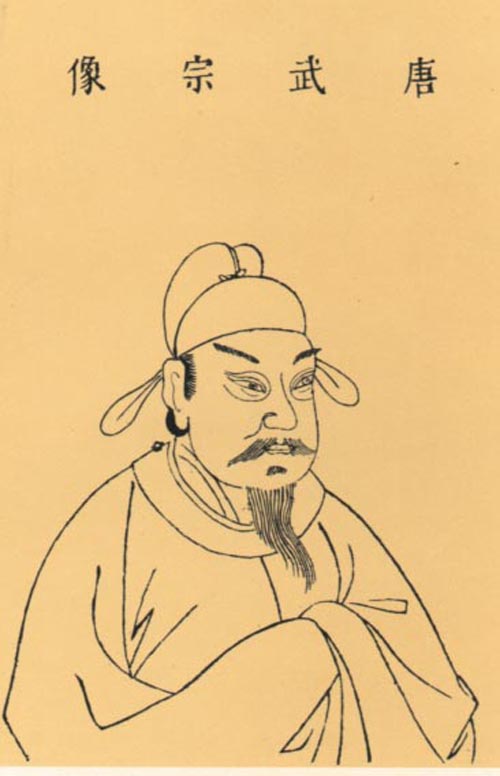
Image Source: Public Domain
About Emperor Wuzong
Reign Years:840 – 846 A.D
Given Name: Li Yan
Reign Name:Emperor Wuzong

Image Source: Public Domain
Reign Years:840 – 846 A.D
Given Name: Li Yan
Reign Name:Emperor Wuzong
Emperor Wuzong was born with the name Li Chan. He became one of the Tang Dynasty emperors of China who ruled from 840 to 846.
Wuzong of Tang was primarily known for the religious expulsion that happened during his rule. The emperor was also known for his numerous actions against the attacks of the remaining Huigu Khanate. This also included the rebellion led by Liu Zhen.
Go back in time and follow the timeline and emperors of the Tang Dynasty.
Read MoreIn 814, Li Chan was born as the 9th son of Emperor Muzong and Consort Wei. After his father became emperor in 820, he set a lot of his sons and brother as princes in 821. There, Li Chan was made the Prince of Ying.
Little is known about Li Chan’s activities during his father or older brother’s rule. Yet during the Kaicheng Era of Wenzong, the emperor bestowed Li Chan with the honorary title of Kaifu Yitong Sansi.
Emperor Wenzong became severely ill in 840. He ordered his trusted eunuchs to entrust the crown prince Li Chengmei to them. However, these eunuchs were against Li Chengmei, so they made Li Chan crown prince.
After Emperor Wenzong’s death, Li Chan eventually ascended the throne as Emperor Wuzong.
Wuzong of Tang is most remembered today for his Buddhist persecutions, one of the worst events in China’s history. However, he managed to prevent internal political issues and eunuch dominance in the Tang Dynasty.
Buddhism greatly flourished in China as a vital force during the Tang Era. With that, its monasteries were able to enjoy a tax-exempt status.
Since they didn’t contribute any taxes, the Tang Dynasty emperor believed that Buddhism would eventually drain the state’s economy. Coupled with his commitment to Taoism and deep trust with Zhao Guizhen, a Taoist monk, he acted against Buddhism.
There, he initiated an imperial edict that weeded-out convicts and sorcerers from the ranks of Buddhist nuns and monks. Then, he returned them to lay life.
These monks and nuns had to turn over their wealth to the government. That’s unless they went back to lay life and paid taxes.
During the first phase, arguments for the reform of Buddhist institutions were great. Protecting society from Buddhist practices and influences was predominant as well. Religious oppression reached its height in 845, and there, Buddhist temple properties were ultimately confiscated.
The government destroyed around 4,600 temples and 40,000 shrines. Plus, they removed around 260,500 nuns and monks from the monasteries.
The reasons of Emperor Wuzong for doing such weren’t entirely economic. He claimed that Buddhism was a harmful foreign religion to the Chinese society. One notable victim of the Tang Dynasty ruler’s persecution was Ennin, a Japanese Tendai monk.
Aside from the internal troubles and issues, Wuzong of Tang also faced issues beyond the empire’s borders.
Nanzhao was an autonomous tribute kingdom located in the south-west region. They’ve continuously displayed great territorial ambitions by assaulting Chengdu. From there, they continued pushing their claims during the reign of Emperor Wuzong.
Another issue was the Turkic Uyghurs in the north, who also wanted to redraw their borders with China.
In 840, over 100,000 nomads gathered along China’s borders, specifically close to the Huang Ho River. The immediate response of the empire was to boost their border defenses and establish new fortresses.
In addition, they added more armed forces in that place since it’s been left somewhat depleted for decades.
In 843, the Tang Dynasty moved and attacked the Uyghur camp. This was before they chased the enemy straight to the Gobi desert. There, 10,000 tribespeople died, and 20,000 were taken as captives.
A mountain at the location of the massacre got the name Sha Hu Shan or Kill the Huns Mountain.
In both situations, the emperor, with the assistance of Li Deyu, was able to defend and protect the status quo. To reward Deyu for his successful campaign against the Uyghurs, he was made the Duke of Wei in 844.
This magnificent ฺBlue and White Ming vase is perfectly preserved with traditional cobalt oxide blue tones that still glow like the first day. The piece begins with a slim foot that makes way for exquisitely defined arches spread across the base.
Buy Now!The blue glaze of the traditional cobalt oxide of this early Ming Dynasty porcelain jar shines like the first day.Its base with a slim foot opens the way to a double-line medallion that cements the main figure
Buy Now!This elegant blue and white Ming vase was painted exclusively in exquisite blue tones of traditional cobalt oxide has been superbly preserved. Its base begins with elegant floral arches between two double medallions.
Buy Now!Late in the life of Emperor Wuzong, he started taking pills created by Taoist alchemists. These pills were supposedly made to lead one to immortality.
However, there were claims stating that Wuzong of Tang’s mood became unpredictable and harsh due to the pills’ side-effects. By 845, he ended up falling seriously ill.
The next year, they tried to ward off his illness by changing his name to Li Yan. They somehow had this theory under the cosmology of Wu Xing.
It stated that his name, Chan, had two instances of earth and one instance of water. It meant that the emperor was getting suppressed by the empire’s spirits.
It’s a Tang Dynasty belief that the empire was protected by earth. And while “Yan” had two instances of fire, it was claimed to be more ideal with earth.
Yet despite changing his name, the Tang Dynasty emperor’s conditions worsened. And since his two sons were still too young to take the throne, he was instead succeeded by Emperor Xuanzong, his uncle.
During Xuanzong’s reign, he reversed the Buddhist persecution.
Join the VIP club, Get Auction notification, special offers and more!